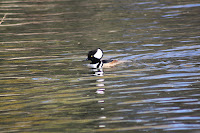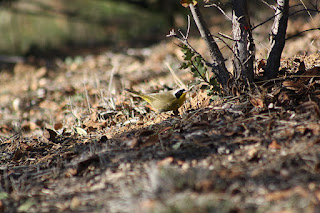Oak Canyon Community Park
_________________________________________________________
Phainopepla
Total: 1
This park still had quite an appeal and I wasn't surprised because it had quite a range of habitats that spread out over a large region. In fact the question was not whether the place had the birds; it was finding them. While it is true that the larger the habitat the more birds, it isn't an equal equation. In such places the birds scatter themselves and it takes more time and luck to locate a "good" count.
 The duck pond still continued to live up to its name, though it did seem that there were less Mallards than normal. What was more surprising was the Ring-necked ducks literally pecking around my feet at crumbs. About a month ago when I saw my first Ring-necks here they were very skittish and did not have a wide radius of tolerance for people. If the food (provided by the local people) was enough then surely they would return as a regular visitor to this spot, and I don't think it would be at all farfetched to consider that they may become a late winterer and stay into spring outside the typical stay of this species in Los Angeles.
The duck pond still continued to live up to its name, though it did seem that there were less Mallards than normal. What was more surprising was the Ring-necked ducks literally pecking around my feet at crumbs. About a month ago when I saw my first Ring-necks here they were very skittish and did not have a wide radius of tolerance for people. If the food (provided by the local people) was enough then surely they would return as a regular visitor to this spot, and I don't think it would be at all farfetched to consider that they may become a late winterer and stay into spring outside the typical stay of this species in Los Angeles.  |
| A flash of white; whatever could it be? |
 |
| Jasper NP, Alberta. November '09 |
I had only seen this bird twice before; once in a waterfowl collection in England and my first "tick" in Alberta, where my parents stopped off the side of the road so I could look through the massive flocks of ducks on one such large lake in the Rockies, and I ended up being rewarded with speck-sized glimpses of the males white hood that were only just identifiable (and when you are discussing the identifiable-ness of the world's most distinctive duck it certainly means something!) through full zoom, in only one of the photos I took.
 |
| Beady yellow eyes.... |
This sighting was not distant at all. But it was skittish, and even more so than the Ring-necks. As soon as I started to make my way around the lake it had its beady yellow eyes on me. Fortunately for me the middle of the lake was considerably thinner and the bird was forced to traverse this narrow stretch to "escape", giving me good looks of its plumage. They say birds that flee have had bad encounters with humans in the past, but I can't imagine that this bird would have seen many people (let alone hunters) though perhaps its ancestors have, and passed those memories down the line. The duck was pretty confused when it was nearly a metre away and was frantically turning backwards and forwards trying to get as far away as it could until it eventually took off to the back of the pond. Surely someone must have pointed a gun at it, because it was possibly one of the most anxious birds I have encountered.
 | ||
This way.
|
 |
| Statue. |
 |
| Oh, he's definately there. |
Up at the other region of the park was nothing extraordinary, but there were more Hermit Thrushes just beyond the road that led down a ramp and across the creek into the dog park area. And there was quite a lot of them. In the end I believe there was about 4 - 6 birds. In one area many birds flocked together (which I found odd as I never pictured the Hermit Thrush as a sociable bird) and were gleaning red berries, much like my memory of Song/Mistle Thrushes back in the U.K., but they still were persistent in being ubiquitous and only made brief appearances, most of which consisted of the below category:
Compared to the single bird before this was quite something for me. I guess they were common after all.
There was nothing else worth mentioning, but on Boxing Day (today) a lust for getting fresh air returned me to this spot.
On the duck pond side of things, the Hooded Merganser was not present, and there went the thought of it staying the rest of the winter.
 Up at the other side, a familiar but unnameable (I always forget this one!) twanging call showed me the presence of a male Common Yellowthroat a few metres ahead foraging in the leaf little...and entirely in the open! You may or may not know, but this dense cover specialist rarely flashes more than a trace of its yellow chest as it mysteriously poofs into thin air. This was by far my best sighting of this bird, far excelling shadow-dappled figures I had managed to photograph in the past, and guess what. The pictures were focused. Nothing else to ask other than a better background....
Up at the other side, a familiar but unnameable (I always forget this one!) twanging call showed me the presence of a male Common Yellowthroat a few metres ahead foraging in the leaf little...and entirely in the open! You may or may not know, but this dense cover specialist rarely flashes more than a trace of its yellow chest as it mysteriously poofs into thin air. This was by far my best sighting of this bird, far excelling shadow-dappled figures I had managed to photograph in the past, and guess what. The pictures were focused. Nothing else to ask other than a better background.... |
| Unfortunately the meeting was short when a Ranger's truck happened to drive very close to our position. The bird disappeared entirely after that. |
 |
| I was *this* close to getting a shot of this bird in the sun.... It was the camera shutter that made it flip. |
Ahead the Hermit Thrushes persisted in the same spot.
Nothing else was worth mentioning, but a dry rattling trill did catch my attention. I heard it in various places in the stay, but only in one place at a time; assumably it was a single bird. It sounded woodpeckery (could have easily been a Ladder-back or a Sapsucker) but I could have easily imagined it coming from a Yellowthroat. I managed to trail the source into an especially thick clump of shrubs and when I got into a place where I could see it the bird flushed into the wilderness. I still don't know what it was, but I will we scouring Xeno Canto tonight to see if I can put a name to it.
A party of White-crowned Sparrows numbered in the twenties and I did my best to check for other sparrows before they all vanished into the undergrowth but I didn't see anything strange.
The subtle presence of a Red-shouldered Hawk was perched on a very low branch just over my head. It took me a while to notice it, even though I was in the immediate area for a while.
A party of White-crowned Sparrows numbered in the twenties and I did my best to check for other sparrows before they all vanished into the undergrowth but I didn't see anything strange.
The subtle presence of a Red-shouldered Hawk was perched on a very low branch just over my head. It took me a while to notice it, even though I was in the immediate area for a while.
 |
| Another statue. |
 |
| On command. |
With that ahead I decided to take a less familiar path into the hills. I say into the hills, but it was no more than the back of the car park. Now at this point I had one of those strange birding moments. I was thinking about how perfect this habitat would be for a unique little desert bird called a Phainopepla, which is when a black, long-tailed bird popped up on the height of a shrub.
The Phainopepla is more-or-less a chaparral specialist, and they had been reported in the near vicinity (less than a mile away), so why had I not seen one here? I hear Wrentits at this location often, and if you are hearing those then you know that you are in chaparral habitat and nowhere else. I guess I will no longer be wondering about that.
This glossy (male) or dusky (female) bird is a close relative to the Waxwing(s) and you could see it in the face as it turned its head. From the side it looked completely unique, but a little tilt and you could see the resemblance, especially in the crest and the bridled "eyeshadow". I assumed the bird was a female because it seemed rather dull, but its red eye suggested otherwise. It was clearly an immature, which was pointed out by its pale edging to the wings. Adult males are entirely glossy black with no impurities.
 |
| You're not seeing things. This strange creature is trying to talk like you. |
It was one of the few birds that could be attracted by something related to pishing. It's simply mimicry. The Phainopepla has a very simple whistling call. If you can whistle then you're sorted. The bird never actually whistled itself but whenever I did it would shoot up from its cover and cock its head at me, so it was clearly paying attention. Strangely the nearby Yellow-rumped Warblers also seemed to be attracted by it. I guess it was just warbler curiosity. I was not sure if whistle-pishing would work that frequently, so it was something to experiment with in the future I guess.
The sound of Waxwings and a Red-tailed Hawk over the hills near the car park held the final avian traces on today's visit.



















No comments:
Post a Comment